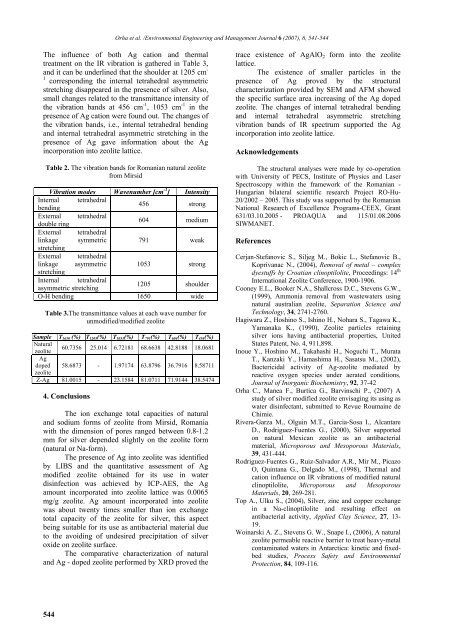2007_6_Nr6_EEMJ
Create successful ePaper yourself
Turn your PDF publications into a flip-book with our unique Google optimized e-Paper software.
Orha et al. /Environmental Engineering and Management Journal 6 (<strong>2007</strong>), 6, 541-544<br />
The influence of both Ag cation and thermal<br />
treatment on the IR vibration is gathered in Table 3,<br />
and it can be underlined that the shoulder at 1205 cm -<br />
1 corresponding the internal tetrahedral asymmetric<br />
stretching disappeared in the presence of silver. Also,<br />
small changes related to the transmittance intensity of<br />
the vibration bands at 456 cm -1 , 1053 cm -1 in the<br />
presence of Ag cation were found out. The changes of<br />
the vibration bands, i.e., internal tetrahedral bending<br />
and internal tetrahedral asymmetric stretching in the<br />
presence of Ag gave information about the Ag<br />
incorporation into zeolite lattice.<br />
Table 2. The vibration bands for Romanian natural zeolite<br />
from Mirsid<br />
Vibration modes Wavenumber [cm -1 ] Intensity<br />
Internal tetrahedral<br />
bending<br />
456 strong<br />
External tetrahedral<br />
double ring<br />
604 medium<br />
External tetrahedral<br />
linkage symmetric 791 weak<br />
stretching<br />
External tetrahedral<br />
linkage asymmetric 1053 strong<br />
stretching<br />
Internal tetrahedral<br />
asymmetric stretching<br />
1205 shoulder<br />
O-H bending 1650 wide<br />
Table 3.The transmittance values at each wave number for<br />
unmodified/modified zeolite<br />
Sample T 1650 (%) T 1205 (%) T 1053 (%) T 791 (%) T 604 (%) T 456 (%)<br />
Natural<br />
zeolite<br />
60.7356 25.014 6.72181 68.6638 42.8188 18.0681<br />
Ag<br />
doped 58.6873 - 1.97174 63.8796 36.7916 8.58711<br />
zeolite<br />
Z-Ag 81.0015 - 23.1584 81.0711 71.9144 38.5474<br />
4. Conclusions<br />
The ion exchange total capacities of natural<br />
and sodium forms of zeolite from Mirsid, Romania<br />
with the dimension of pores ranged between 0.8-1.2<br />
mm for silver depended slightly on the zeolite form<br />
(natural or Na-form).<br />
The presence of Ag into zeolite was identified<br />
by LIBS and the quantitative assessment of Ag<br />
modified zeolite obtained for its use in water<br />
disinfection was achieved by ICP-AES, the Ag<br />
amount incorporated into zeolite lattice was 0.0065<br />
mg/g zeolite. Ag amount incorporated into zeolite<br />
was about twenty times smaller than ion exchange<br />
total capacity of the zeolite for silver, this aspect<br />
being suitable for its use as antibacterial material due<br />
to the avoiding of undesired precipitation of silver<br />
oxide on zeolite surface.<br />
The comparative characterization of natural<br />
and Ag - doped zeolite performed by XRD proved the<br />
trace existence of AgAlO 2 form into the zeolite<br />
lattice.<br />
The existence of smaller particles in the<br />
presence of Ag proved by the structural<br />
characterization provided by SEM and AFM showed<br />
the specific surface area increasing of the Ag doped<br />
zeolite. The changes of internal tetrahedral bending<br />
and internal tetrahedral asymmetric stretching<br />
vibration bands of IR spectrum supported the Ag<br />
incorporation into zeolite lattice.<br />
Acknowledgements<br />
The structural analyses were made by co-operation<br />
with University of PECS, Institute of Physics and Laser<br />
Spectroscopy within the framework of the Romanian -<br />
Hungarian bilateral scientific research Project RO-Hu-<br />
20/2002 – 2005. This study was supported by the Romanian<br />
National Research of Excellence Programs-CEEX, Grant<br />
631/03.10.2005 - PROAQUA and 115/01.08.2006<br />
SIWMANET.<br />
References<br />
Cerjan-Stefanovic S., Siljeg M., Bokic L., Stefanovic B.,<br />
Koprivanac N., (2004), Removal of metal – complex<br />
dyestuffs by Croatian clinoptilolite, Proceedings: 14 th<br />
International Zeolite Conference, 1900-1906.<br />
Cooney E.L., Booker N.A., Shallcross D.C., Stevens G.W.,<br />
(1999), Ammonia removal from wastewaters using<br />
natural australian zeolite, Separation Science and<br />
Technology, 34, 2741-2760.<br />
Hagiwara Z., Hoshino S., Ishino H., Nohara S., Tagawa K.,<br />
Yamanaka K., (1990), Zeolite particles retaining<br />
silver ions having antibacterial properties, United<br />
States Patent, No. 4, 911,898.<br />
Inoue Y., Hoshino M., Takahashi H., Noguchi T., Murata<br />
T., Kanzaki Y., Hamashima H., Sasatsu M., (2002),<br />
Bactericidal activity of Ag-zeolite mediated by<br />
reactive oxygen species under aerated conditions,<br />
Journal of Inorganic Biochemistry, 92, 37-42<br />
Orha C., Manea F., Burtica G., Barvinschi P., (<strong>2007</strong>) A<br />
study of silver modified zeolite envisaging its using as<br />
water disinfectant, submitted to Revue Roumaine de<br />
Chimie.<br />
Rivera-Garza M., Olguin M.T., Garcia-Sosa I., Alcantare<br />
D., Rodriguez-Fuentes G., (2000), Silver supported<br />
on natural Mexican zeolite as an antibacterial<br />
material, Microporous and Mesoporous Materials,<br />
39, 431-444.<br />
Rodriguez-Fuentes G., Ruiz-Salvador A.R., Mir M., Picazo<br />
O, Quintana G., Delgado M., (1998), Thermal and<br />
cation influence on IR vibrations of modified natural<br />
clinoptilolite, Microporous and Mesoporous<br />
Materials, 20, 269-281.<br />
Top A., Ulku S., (2004), Silver, zinc and copper exchange<br />
in a Na-clinoptilolite and resulting effect on<br />
antibacterial activity, Applied Clay Science, 27, 13-<br />
19.<br />
Woinarski A. Z., Stevens G. W., Snape I., (2006), A natural<br />
zeolite permeable reactive barrier to treat heavy-metal<br />
contaminated waters in Antarctica: kinetic and fixedbed<br />
studies, Process Safety and Environmental<br />
Protection, 84, 109-116.<br />
544


